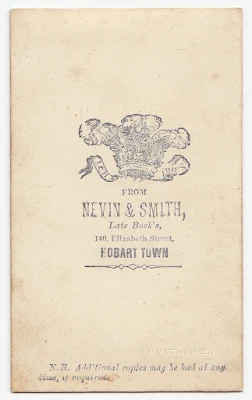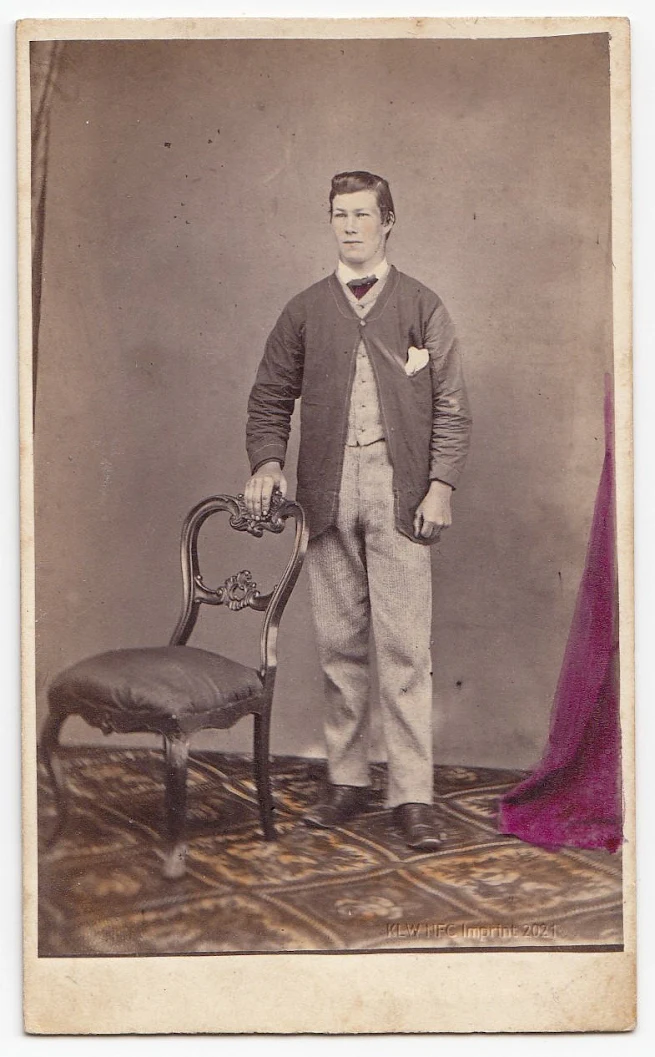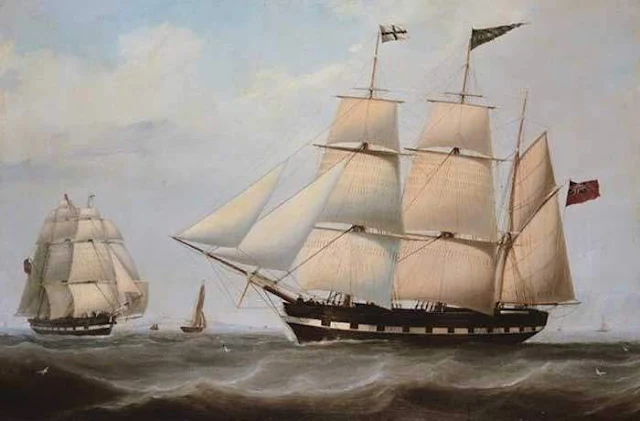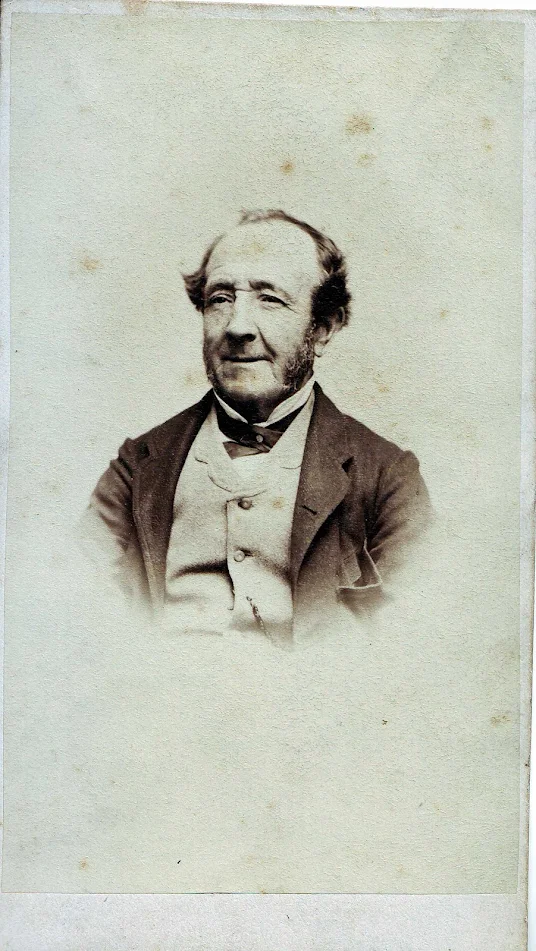THE LOST COLLECTIONS of NEVIN, GENGE, CHANDLER and HOOPER family photographs
INTERGENERATIONAL PHOTOGRAPHERS Thomas J. NEVIN 1870s, and JAMES CHANDLER 1900s
The Chandler and Hooper Collection
Photographer James Chandler (1877-1945) acquired by descent an unknown number of original photographic works taken by his mentor and older "cousin-in-law" photographer Thomas J. Nevin (1842-1923). The early photographs passed hands from Thomas and Elizabeth Nevin's daughter Minnie Drew nee Nevin (1884-1974) and James Chandler (1877-1945) to James' Chandler's nephew Victor L. Hooper (1905-1990). The Archives Office of Tasmania has this collection catalogued thus:
James Chandler (b. Hobart 1877) was a Hobart based photographer. For many years he was a member of the Photographic Society and well-known on the Hobart waterfront as a marine photographer in the 1930s and 1940s. He was the youngest son of William Chandler, a bootmaker, and his wife Mary (nee Genge), the first couple married at the New Town Methodist Church on the 14 Jan 1868. His uncle was Jacob Chandler, a ship builder in Battery Point. He died in Hobart on 8 July 1945.NS434 Photographs of the Chandler, Genge and Hooper Families 01 Jan 1860 31 Dec 1960
NS869 Photographs of General and Maritime Interest 01 Jan 1870 31 Dec 1950
NS1231 Photographs of Hobart and Suburbs, Port Arthur and Ships 01 Jan 1910 31 Dec 1940
Link: https://stors.tas.gov.au/AI/NG1231
Vic (Victor Leonard) Hooper had a large collection of photographs many of which were taken by his Uncle James Chandler, a Hobart marine photographer. Mr Hooper was cremated at Cornelian Bay, Hobart on the 30 Sept 1990, aged 85. He lived at Mount Stuart and then New Town.NS434 Photographs of the Chandler, Genge and Hooper Families 01 Jan 1860 31 Dec 1960
Link: https://stors.tas.gov.au/AI/NS434
On Wednesday 10th November 1926 James Chandler, Hon. Secretary of the Southern Tasmanian Photographic Society, gave a lecture with "views" - lantern slides perhaps, or prints and originals - of the early history of Hobart, most likely with the aid of photographs inherited from his recently deceased mentor and "cousin-in-law" Thomas J. Nevin (1842-1923).
SOUTHERN TASMANIAN PHOTOGRAPHIC SOCIETYSource: PHOTOGRAPHIC SOCIETY. (1926, November 12). The Mercury
A special meeting of the Southern Tasmanian Photographic Society was held on Wednesday night for the purpose of forming an historical section of the society. Mr. F.G. Robinson was in the chair. After the proposed activities of the section had been discussed, it was resolved that an historical section be formed. The following officers were appointed: Chairman, Mr. F.G. Robinson; Hon. Secretary, Mr. J. Chandler.
At the conclusion of the business, a lecture on "Early Hobart" was given by Mr. J. Chandler, who gave a good description of the early history of Hobart. The views shown comprised a record of the growth of Hobart from about 1820 to 1880. A vote of thanks was accorded the lecturer.
Link: https://nla.gov.au/nla.news-article29465630
Obituary for James Chandler, 30 March 1945:
Mr J. Chandler. The funeral of Mr James Chandler, who died at a private hospital at Hobart on Tuesday, took place at the Cornelian Bay crematorium on Wednesday. The service was conducted by the Rev Gordon Arthur. Chief mourners were Mrs E. M. Hooper (sister), Messrs R. W. and V. Hooper (nephews), Misses C. A. and D. Hooper, Mesdames E. Bennett. R. J. Collins, (nieces), Messrs. R. J. Collins, H. Genge, B. Genge, and Max Inches.Mr J. Chandler (1945, March 30). The Mercury (Hobart, Tas. : 1860 – 1954), p. 16.
Mr Chandler was for many years a member of the Photographic Society and was well known on the Hobart waterfront. He was a keen photographer. He was the youngest son of the late William and Mary Chandler, who were the first couple married at New Town Methodist Church. His father was a bootmaker in Hobart for many years, and an uncle, Jacob Chandler, was a ship builder at Battery Pt., and built a number of early river steamers.
https://nla.gov.au/nla.news-article26058706
James Chandler was living on the property owned by his older half-brother Henry Chandler at McRobies Valley when he died on 8th July 1945 (probate reg. March 1946). The Archives Office of Tasmania holds a sizeable collection of his marine and landscape photographic works, several now online at Flickr, for example: -

Mt Wellington view of Hobart from scenic lookout - c1930s
James Chandler, Photographer (NG1231)12 Aug 1877 08 Jul 1945
Tasmanian Archive and Heritage Office: NS869/1/349
Source: https://www.flickr.com/photos/107895189@N03/albums/72157638491468735

Photograph - Ferry 'Kangaroo' - aground
Item Number: NS434/1/162
Date: 1926
Source: Archives Office of Tasmania
Creating Agency: Hooper Family (NG434) 01 Jan 1920
James Chandler, Photographer (NG1231)12 Aug 1877 08 Jul 1945
Series: Photographs of the Chandler, Genge and Hooper Families (NS434)
This is probably the last photograph ever taken of the steam twin vehicular ferry "Kangaroo" built by Elizabeth Rachel Nevin's uncle Captain Edward Goldsmith in 1854-1855 at his patent slipyard on the Queen's Domain in Hobart. It was sold to Askin Morrison in 1857, then to James Staines Taylor in 1864 who operated it for the next 40 years. It was still in operation well into the first decades of the 20th century. Bought by the O'May Bros in 1903, its service was terminated in 1925 and replaced by the "Lurgerena" in 1926.
A boy and his photograph: no longer "Anon"
Item no. NS434-1-121 - "Photograph - Anon - boy - c. 1870s" from the series "NS434 Photographs of the Chandler, Genge and Hooper Families 01 Jan 1860 31 Dec 1960" was listed online at the Archives Office of Tasmania but without the digitised image when a Nevin family descendant recently requested a preview and scan. It was a stab in the dark, a random choice from the two dozen family photographs of the Nevin, Genge, and Chandler families from the Chandler/Hooper collection, more so since neither the "boy" nor the photographer was named.
The scan provided by the AOT revealed this fine portrait of a very handsome eleven year old boy in uniform, immediately identifiable as a portrait taken by Thomas J. Nevin ca. 1871 at his studio and business, the City Photographic Establishment, 140 Elizabeth St. Hobart Town, Tasmania. The Archives Office has since placed the image online, listed as "Photograph - Anon - boy - c. 1870s" despite information we have since provided as to the identity of the photographer, if not the name of the boy's family (viz: https://stors.tas.gov.au/AI/NS434-1-121).

Subject: Unidentified 11 year-old boy, possibly George Chandler b. 1860
Photographer: Thomas J. Nevin (1842-1923)
Location and date: City Photographic Establishment, 140 Elizabeth St. Hobart, Tasmania, 1871
Format: carte de visite housed in a tin frame, studio decor items typically used by Nevin in early 1870s.
Details: Copy from negative made from collection lent to the Archives Office of Tasmania in 1974
Item catalogued as "Photograph - Anon - boy - c. 1870s"
Location and condition of original photograph and frame unknown.
Provenance: Series: Photographs of the Chandler, Genge and Hooper Families (NS434) 01 Jan 1860 31 Dec 1960
Source: Archives Office of Tasmania - https://stors.tas.gov.au/AI/NS434-1-121
NB: slightly colorised for display here from the black and white digital copy supplied by AOT.
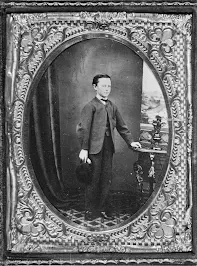

Verso: "Anon" is pencilled on back of paper print of this cdv taken by Thomas J. Nevin ca. 1871.
Archives Office of Tasmania.
Source: https://stors.tas.gov.au/AI/NS434-1-121
Photographs of the Chandler, Genge and Hooper Families
Series Number: NS434
Access: Open
Start Date: 01 Jan 1860
End Date: 31 Dec 1960
Source: Tasmanian Archives
Creating Agency: Hooper Family (NG434) 01 Jan 1920
James Chandler, Photographer (NG1231) 12 Aug 1877 08 Jul 1945
Series notes: Copies of originals only. Original photographs lent to the Archives Office of Tasmania by Mr Hooper in 1974 to be copied. The collection includes predominantly photographs of the Chandler, Genge and Hooper families, but also some of Beaumaris Zoo, Hobart and other views. These records are part of the holdings of the Tasmanian Archives.
Information supplied by the Archives Office along with the request and the scan proved disappointing, apart from the fact that the scan they were providing was a copy of a copy. Nothing was known about the location of the original photograph from which this copy was made when it was deposited there in 1974 on Minnie Drew's death.
This item is a copy of a photograph in a frame lent to the Archives Office by the owner for photographing back in 1974. We made negatives at the time, and your copy is printed from a negative. As for the back of the photograph, on the back is written ‘anon’, and nothing else.From: Response to information by email from Archives Office of Tasmania, email 14 October 2021
Just copies printed from negatives of originals lent to the Archives Office of Tasmania - NOT scans of the originals of photographs from the early 1870s of the Nevin, Genge and Chandler families - are all that the Archives Office of Tasmania (AOT) can offer from this collection. The negatives were made in 1974 when they were "lent" by Victor Hooper from the estate of Minnie Drew nee Nevin (1884-1974), daughter of photographer Thomas J. Nevin and Elizabeth Rachel Nevin. None had been digitized by the AOT of any of the early 1860s-1870s photographs that might have been taken by Thomas J. Nevin among the items inherited by Minnie Drew from her parents.
Apart from the 1870s photographs, a number of photographs in this collection are studio photographs taken in the 1890s and later of family members at Launceston and Hobart studios, mostly inherited by Victor Hooper from the estate of his uncle James Chandler (1877-1945) who would become a professional photographer. James Chandler was Thomas Nevin's successor to professional photography, his young "cousin-in-law". He was the son of shoe maker William Chandler and Mary Chandler nee Genge, William's second wife. He was the nephew of Mary Genge's sister Martha Nevin formerly Salter nee Genge, who became the second wife of Thomas Nevin's father, John Nevin snr (1808-1887) in 1879.
The copying of the originals in the collection was arranged for deposit at the Archives of Tasmania in 1974 by Victor Hooper of the funeral firm Hooper & Burgess. As a funeral director and as a nephew of photographer James Chandler, he was not only the organiser of his relative Minnie Drew's funeral in 1974, he was the owner by descent of the whole photographic collection. The original photographs from the original collection appear not to have been purchased or otherwise acquired by the Archives Office from Vic Hooper's estate when he died in 1990. We can only assume therefore that these original photographs of the Nevin, Genge, Chandler and Hooper families are now altogether lost, unless someone somewhere knows something to the contrary (please contact us here).
Identifying the photographer
Even if the identity of boy in this cdv was unknown at first glance, with no information other than the word "Anon" faintly inscribed on the verso, the photographer was immediately identifiable as Thomas J. Nevin from elements which featured in many of his portraits of private clientele from the late 1860s to the early 1870s, viz:
1. the carpet or tapis with lozenge and chain link pattern
2. the table with the griffin-shaped legs
3. the flowers and silver vase (flowers possibly tinted)
4. the drape (possibly tinted dark red)
5. the backsheet of a tiled Italianate balcony and balustrade overlooking a wide cart path beside a stream meandering to low mountains at the horizon.
These elements provided the decor for several portraits taken by Thomas J. Nevin at his studio ca. 1871-1873, but this original and rare cdv of an unidentified woman (below) in particular features the distinctive vase with flowers (tinted in the original) identical with the vase in the cdv of the boy:

Subject: Unidentified woman in black dress, seated on a slipper chair, left arm resting on a table adorned with a book and vase holding flowers, tinted.
Photographer: Thomas J. Nevin (1842-1923)
Location and date: 140 Elizabeth St. Hobart, Tasmania, ca. 1871
Scans courtesy and copyright © The Private Collection of C. G. Harrisson 2006.
This unidentified woman posed for a full length carte-de-visite portrait sitting on Nevin' shiny slipper chair at his table with the griffin-shaped legs. As the same carpet appears in the photograph taken of Thomas J. Nevin and Elizabeth Rachel Day on their wedding day, 12 July 1871, this portrait can be dated ca. 1871-1873. The verso bears Thomas Nevin's most common commercial studio stamp, an elaboration of the stamp used by former lessee of the studio, Alfred Bock.


Verso studio stamp: "T. Nevin late A. Bock, 140 Elizabeth St. Hobart Town"
Detail of above: tinted flowers yellow and rose
A consistent feature of Thomas Nevin's cartes-de-visite taken of private clients and family members at his studio, 140 Elizabeth St. Hobart Town circa 1871 is delicate hand-tinting. The detail (above) of the flower arrangement shows a fine touch. Given the similarities with the vase in both cdvs, there is a slight chance this woman was a relative of the boy, in which case, both photographs were most likely taken in the same session.
Identifying the boy
Since the date when these elements were a feature of Nevin's studio decor, the boy in this photograph was possibly George Chandler, born a twin with Elizabeth Chandler on 24th November 1860 to William Chandler's first wife, Kezia Cox. The female twin Elizabeth died in 1862, aged 15 months.
George Chandler would have been 11 or 12 years old when he visited Thomas J. Nevin's studio for this photograph in 1871. To the 21st century viewer, he appears to be formally dressed in a plain suit with white shirt, dark tie and shiny shoes. The bulge in the back of his jacket is mysterious, a satchel perhaps, or even a shortened headrest designed to hold children steady. The hat in his right hand has a leather visor, possibly part of a schoolboy's or postal apprentice's uniform. Posed standing and slightly turned to his right, his gaze and smile towards the photographer might even suggest he found the encounter pleasing and fascinating. The intricate frame in which the family placed this cdv of George Chandler looks like pressed tin rather than carved wood. However, this is just a black and white copy of a black and white copy of the original, so other aspects such as the watermarks on the back wall are not easily explained. The flowers in the original may have been tinted; they may have been the very same flowers only seen previously in the cdv of the woman (above).

Detail of "Photograph - Anon - boy - c. 1870s"
https://stors.tas.gov.au/AI/NS434-1-121

Subject: Unidentified 11 year-old boy, possibly George Chandler born 1860.
Photographer: Thomas J. Nevin (1842-1923)
Location and date: City Photographic Establishment, 140 Elizabeth St. Hobart, Tasmania, 1871
Format: carte de visite housed in a tin frame, studio decor items typically used by Nevin in early 1870s.
Details: Copy from negative made from collection lent to the Archives Office of Tasmania in 1974
Item catalogued as "Photograph - Anon - boy - c. 1870s"
Location and condition of original photograph and frame unknown.
Provenance: Series: Photographs of the Chandler, Genge and Hooper Families (NS434) 01 Jan 1860 31 Dec 1960
Source: Archives Office of Tasmania - https://stors.tas.gov.au/AI/NS434-1-121
NB: slightly colorised for display here from the black and white digital copy supplied by AOT.
Given the textual similarities of this cdv and the cdv of the unidentified woman (above), there is a slight chance she was a relative of the boy, in which case, both photographs were most likely taken together on the same day, and her presence might therefore suggest she was George Chandler's step-mother Mary Chandler nee Genge (1835–1923). If so, she would have been 36 years old in 1871.
George Chandler's mother Kezia Chandler nee Cox, was William Chandler's first wife. Kezia Cox married William Chandler (1825-1907) on 31 May 1855 and bore him four (4) children while living at Wilmot St. near Hampden Road, Battery Point where William operated his bootmaker's shop:
1856: William James Chandler born April 14th 1856.
1858: Henry Bayley Chandler (known as Harry) b. n.d.
1860: Twins - George Chandler and Elizabeth Chandler born on 24 November 1860.

3932 Chandler, Elizabeth, female
3933 Chandler, George, male
Record Type: Births
Chandler, William, father
Cox, Kezia mother
Date of birth: 24 Nov 1860
Registered: Hobart
Record ID:NAME_INDEXES:965451
Resource:RGD33/1/8 no 3932 and 3933
Archives Office of Tasmania
Source: https://stors.tas.gov.au/NI/965451
The twin girl, Elizabeth Chandler died of diarrhea at Battery Point at 15 months on 20th February 1862. Her death was registered by a friend, Elizabeth Clark. It is now clear from this information lately provided by Nicole Mays, descendant of Jacob Bayly Chandler (pers. comm, 3 May 2022) , that William's wife, Kezia Chandler nee Cox died in 1865, and that their son George settled in New Zealand where he died in 1922:
William Chandler, his wife Kezia (nee Cox) and their two surviving children (Henry Bayly and George) emigrated from Hobart to Invercargill, New Zealand, travelling on board the barque Eucalyptus on 12 November 1862.Information courtesy of Nicole Mays, pers. comm. 3 May 2022
William went on to re-establish himself as a shoemaker in New Zealand, also importing boots and leather from Hobart. Sadly, two melancholy events deeply affected his ability to stay in New Zealand. His business was partly destroyed by fire in late 1864 and, more personally, his wife Kezia died the following year. She was reported to be 38 years old.
William remained in New Zealand only for a short time and returned to Hobart with his two sons in early 1866. The trio travelled on board the SS South Australian which left Hokitika on 1 March of that year, arriving at Melbourne six days later....
George Chandler later returned to New Zealand where he settled. He married Mary Kate Avenell at the Wesleyan Church, Devonport, New Zealand, on 25 April 1889. The couple had three children: Grace, Olive and William Eric. George died at Rotorua, New Zealand in 1922. Many of the photos in the NS434 collection appear to relate to a trip that George, Kate and their two young daughters took to Hobart in the early 1900s.
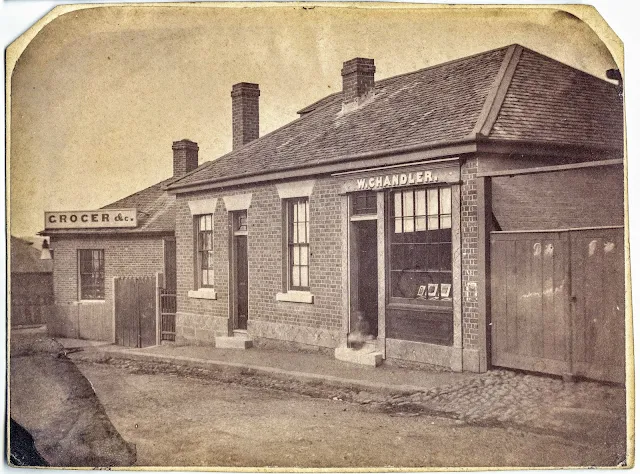
W. Chandler's store, Wilmot Street, (off Hampden Road) Hobart c 1880s
Photographer: possibly half stereo, T. J Nevin 1880s
Item: NS869-1-455_2 Link: https://stors.tas.gov.au/AI/NS869-1-455
Archives Office Tasmania
Shoemaker William Chandler (1825-1907) married his second wife Mary Genge (1835–1923) on 14 January 1868. Mary Genge bore three children in this marriage. When her first child Ethel Chandler was born in 1869, they were resident at William's new business address, 271 Elizabeth St. Hobart, but when James Chandler was born in 1877, they were resident at Thomas Nevin's former studio, 140 Elizabeth St. Hobart.
1869: Ethel Mary Chandler born 20 May 1869.
1874: Arthur William Chandler, b. (?) baptism 4 Nov 1877, died 3 yrs old
1877: James Chandler born 12 August 1877.
The surviving children of William Chandler's first marriage to Kezia Cox - George, Henry and William Chandler jnr - were James Chandler's older half-brothers.
James Chandler (1877-1945) was born in August 1877 at Thomas J. Nevin's former photographic studio, 140 Elizabeth St. Hobart. Hardly predictable but ultimately not altogether surprising is that he grew up to become a professional photographer. His father William Chandler had acquired the lease from owner John Henry Elliott on Thomas Nevin's appointment to the civil service with residency at the Hobart Town Hall in 1876. William Chandler snr operated a shoe-making business at Nevin's old studio up until 1890, when he moved with his son James to premises at 39 Liverpool St. Hobart.
The Nevin, Genge and Chandler family network
The common affiliation of these three families was the Wesleyan church. Irish born John Nevin snr (1808-1887), journalist, poet and former soldier of the Royal Scots First Regiment with service in the West Indies and Canada, had arrived on the convict transport Fairlie in July 1852 as a pensioner guard with his family - wife Mary Ann nee Dickson, and four children under 12 years - Thomas James, Rebecca Jane, Mary Ann and William John. He leased an acre of land at Kangaroo Valley (Hobart, now Lenah Valley) from the Trustees of the Wesleyan Church on which he settled his family in 1854. John Nevin snr maintained the Wesleyan Chapel and schoolhouse there until his death in 1887. His second marriage, on the death of his wife Mary Ann Nevin (nee Dickson) in 1875, was to Martha Genge (1833-1925) (formerly Salter) in 1879, the widowed daughter of his close friend William Genge, preacher and stone mason of the Wesleyan Church in Melville St. Hobart. Martha's sister was Mary Chandler nee Genge, mother of James Chandler (1877-1945) who would become Thomas J. Nevin's successor to the vocation of photography within the extended family network at the turn of the 20th century.
William Chandler (1825-1907), bootmaker from Dover, Kent, arrived at Hobart on the Calcutta in October 1846 accompanied by his sister Mary Selina Chandler to join their brother, boat builder Jacob Bayly Chandler (see below, Nicole Mays, 2011:65). Jacob Bayley Chandler married Martha Macbeth in 1861. She died aged 38, in 1867, daughter of Peter Macbeth. William Chandler and Mary Genge married at the new Wesleyan Church on New Town Road, Hobart in 1868.
William Genge snr, Wesleyan preacher and stonemason had arrived in Hobart from Liverpool on the Prompt, 768 tons, on 3 July 1857, as a bounty immigrant of 214 in total, bringing his wife, four sons (glovers by trade) and one daughter, Mary Genge (1835-1923) leaving behind his other daughter, Martha Genge (Mercury, 3 July 1857, p. 2). Martha arrived two decades later, by then a widow (formerly Salter). She sailed from Plymouth (UK) on 21st June 1878 on board the Somersetshire. She disembarked at Melbourne (Victoria) and boarded the Tamar for Hobart Town, arriving on 16th August 1878 (Edward Freeman, agents). She was listed as an immigrant, 43 yrs old, without children, a Wesleyan who could read and whose stated qualification was "needlewoman". She was born in Taunton, Somersetshire, England, to William Genge, her father who was already resident in Hobart, the sponsor who paid the bounty of £16 for her ticket (No. 215). His application was signed off by B. Travers Solly on 16th August 1878, and forwarded to Treasury on 22nd August 1878. One year later, Martha Salter nee Genge married John Nevin snr on 23 October 1879 at the Wesleyan Chapel Melville Street Hobart Tasmania. Her sister Mary Genge had married bootmaker William Chandler at the Wesleyan church, New Town, in 1868. With these marriages and religious affiliations, the Nevin, Genge and Chandler families developed interdependent lives.

Martha Nevin, formerly Salter, nee Genge (1833-1925)
Tasmanian Archives and Heritage Office
TAHO Ref: NS434/1/194 copy
Original photos by Thomas J. Nevin taken at his New Town studio October 1879
Photo taken at the Archives Office Tasmania. Copyright © KLW NFC 2012
On Thomas Nevin's appointment to the civil service as Office and Hall Keeper of the Hobart Town Hall in 1876, the lease on his photographic studio was taken over by William Chandler who established his shoe-making business there. The proprietor of the premises at 140 Elizabeth St., formerly Nevin's photographic studio and before him, Alfred Bock's, was John Henry Elliott of Brown St. in 1875 when Nevin advertised the lease. John Elliott was also the proprietor of the hotel next door, the "Royal Standard", at 142 Elizabeth St. on the corner of Patrick and Elizabeth Streets. His daughter Dora Tryphena Elliott was married to Alfred Pedder, the collector of a number of portraits and stereographs taken by Thomas J. Nevin, which were donated to the Tasmanian Museum and Art Gallery in the 1970s.

Mary Chandler (nee Genge) and baby Jim, i.e. James Chandler 1878
Archives Office Tasmania
Link: https://stors.tas.gov.au/AI/NS434-1-144
William Chandler purchased property at New Town in 1877 but continued with the lease for his shoe-making business at Thomas Nevin's studio when his son James aka "Jim" Chandler was born on 12th August 1877 to Mary Chandler (nee Genge), William Chandler's second wife. In 1886, when the street numbers in Elizabeth Street were changed, William Chandler's shoe-making business at 140 Elizabeth St. became 170 Elizabeth St. and the public-house on the corner of Patrick St., the "Royal Standard", formerly 142 Elizabeth became 172 Elizabeth St. Hobart (Tasmanian Gazette, Hobart Valuation Rolls, Archives Office Tasmania).
The street numbers in Elizabeth Street have changed again since Thomas Nevin's former studio, originally at 140 Elizabeth St. in the 1860s-1870s became 170 Elizabeth St. in 1886. Sometime before 1915, 170 Elizabeth St. became 198 Elizabeth St., still three doors from the corner of Patrick Street, and still occupied by bootmakers, viz. William Hawksford in 1915, and H. Bratt, boot repairer, in 1948. The same property at 198 Elizabeth St. is now occupied by the Tasmanian Aboriginal Centre.
1948 Wise's Tasmanian Directory
198 Elizabeth St Bratt H c. bt repr
200 Elizabeth St Thurston Phil H
200 Elizabeth St Thurston Mrs E M, mix business
. . . . . . . . Patrick st ....... .
Source: Wise's Tasmanian Directory
https://stors.tas.gov.au/AUTAS001126438076
By 1890, William Chandler and his teenage son James Chandler were living at the house and shop at 39 Liverpool St. Hobart (J. P. Rowe owner, Victoria). James Chandler established his photography business at 30 Argyle St. Hobart on his father's death in 1907.

James Chandler's photographic studio and shop
30 Argyle St. Hobart 1900s
Archives Office Tasmania
Link: https://stors.tas.gov.au/AI/NS1231-2-14
Although Thomas J. Nevin retired from professional photography in 1888 with the birth of his last child Albert Edward Nevin (1888-1955), the family's birth, death and marriage (BDM) documents indicate he was still active as a photographer into the 1920s. Documents dated right up to his death in 1923 state "Occupation: Photographer." His burial certificate of 1923 carries the same vocational title - "Photographer". The witnesses to the marriage of his daughter Minnie Nevin (1884-1974) to James Henry Alfred Drew in 1907, whether himself or another family member, completed the section of the marriage certificate requiring the bride's father's name and his occupation as - "Thomas Nevin Photographer". Ten years later, in 1917, the signatories to the marriage certificate of his youngest son Albert Edward Nevin - i.e. John and Frances Davis, parents of Albert's bride Emily Maud Davis (1898-1971) - registered Albert's father Thomas Nevin's occupation as "Photographer". Family members who readily documented his occupation on these BDM forms would have informed the Registrar otherwise, had it not been the case that Thomas J. Nevin snr was still working in his profession.
While the sons of Thomas Nevin's contemporaries in his photographer cohort - Henry Hall Bailey and Stephen Spurling, for example - carried on the family business into the 20th century, Thomas and Elizabeth Nevin's four adult sons - Tom (Thomas James Nevin jnr aka Sonny), George, William and Albert - showed a preference for thoroughbred-training and racing over photography as a vocation. Thomas J. Nevin snr looked to James Chandler as the beneficiary of his photographic expertise. He was thirty-three (33) years older than James Chandler, a sort of "older cousin" by virtue of the marriage late in life of his father John Nevin snr to James' aunt Martha Nevin (formerly Salter nee Genge) sister of his mother Mary Chandler. Ironically, Thomas' eldest son, Tom or Sonny Nevin took to shoe-making which was the occupation of James' father William Chandler. The sons of these two families effectively swapped their fathers' occupations as their own paths to follow.
Thomas J. Nevin resided at 270 Elizabeth St. (North) Hobart with his wife Elizabeth Rachel Day and eldest daughter May Nevin (1872-1955) in his final years at the premises once occupied by William Genge and managed by his sons Thomas and James Genge, former neighbours at Kangaroo Valley. When William Genge died on the 16th January 1881, at 78 years old of apoplexy and paralysis, John Nevin wrote and published a heart-felt lament on the death of his friend who - by dint of John Nevin's marriage at 75 years old to William's daughter Martha Genge at 46 years old - was also his father-in-law, though both men were born in 1808. William's son Thomas Genge purchased John Nevin snr's land grant of ten acres at Cradoc, near Cygnet, south of Hobart in 1882 five years before John Nevin's death in his beloved garden at Kangaroo Valley in 1887.
Photographer: James Chandler
Archives Office of Tasmania Ref: NS434/1/103
Martha Nevin nee Genge (left) and her sister Mary Chandler nee Genge (right) at Mt Stuart, Hobart, ca. 1910-1920.
Addenda 1: Genge family
William GENGE (1808–1881) was born on 20 October 1808 at Norton, Sub Hamdon, Somerset (UK) and died on 17 January 1881 at Hobart, Tasmania. His wife Mary Genge nee SLADE (1807–1891) was born on 13 March 1807 at Chiselborough, Somerset England and died on 29 July 1891 at Hobart, Tasmania, Australia.

William Genge and Mary Genge nee Slade, 1870s
Hobart, Tasmania. Unattributed.
Photo copyright and courtesy of © Louise Genge, Private Collection.
1851: UK CENSUS
Father: William Genge was 42 yrs old, a stone cutter and local Wesleyan preacher
Mother: Mary nee Slade (his wife) was 45 yrs old, a glover
Son: John Genge was 21 years old, a stone-cutter
Son: Joseph Genge was 19 years old, a pauper
Daughter: Martha Genge was 17 yrs old, a glover
Daughter: Mary Genge was 15 yrs old, a glover.
Son: Thomas Genge was 10 years old
Son: David Genge was 6 years old
Son: James Genge was 3 years old
BIRTH and DEATH DATES
William Genge Head 42 (1808–1881)
Mary Genge Wife 45 (1807–1891)
John Genge 21 (1829–1892)
Joseph Genge 19 (1831–1905)
Martha Genge 17 (1833-1925)
Mary Genge 15 (1835–1923)
Thomas Genge 10 (1842–1915)
David Genge 6 (1844–1915)
James Genge 3 (1847–1927)
Theophalous Genge 4 months (1850–1851)
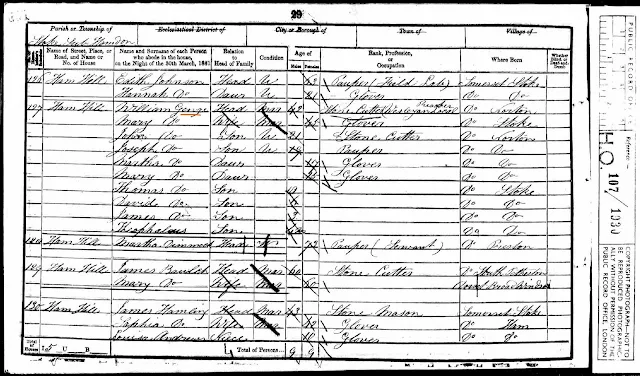
1851 or 1855 (?) Census, Somersetshire, UK
Ref: somho107_1929_1930-0454
1857: ARRIVAL at HOBART (Tas)
William and Mary Genge arrived at Hobart, Tasmania in 1857 with four sons and one daughter on board the Prompt as bounty immigrants, sponsored by Henry CHILDS. They arrived without Martha Genge. She would arrive in 1878 and marry Thomas Nevin's father John Nevin snr in 1879.
Summary details:
William Genge, Married, 45 yrs old. Religion, Methodist. Education, R & W. Native place, Somersetshire. Trade, Quarryman. Name of person on whose application sent out, Henry Childs. Amount of Bounty £16.
Mary Genge, married, 44 years old. Glover
Joseph Genge, single, 21 years old. Quarryman.
Mary Genge, 18 years old.
Thomas Genge, 13 yrs old. Baker's lad
David Genge, 11 years old.
James Genge, 9 years old.
Henry John CHILDS was the person on whose application the Genge family was sent out. Henry Childs was 39 years old when he arrived with his family in 1854. He was a schoolmaster at Old Beach with the birth of six more children after the birth of a female child on board the Maitland in 1854 on the voyage out. Emma was born in 1856, Angelina was born in 1857, and no name male child was born in 1858. Henry Childs was listed as bootmaker at New Town Road in 1859, a cordwainer in 1861 and a bootmaker when he died aged 84, on 30 July 1898.
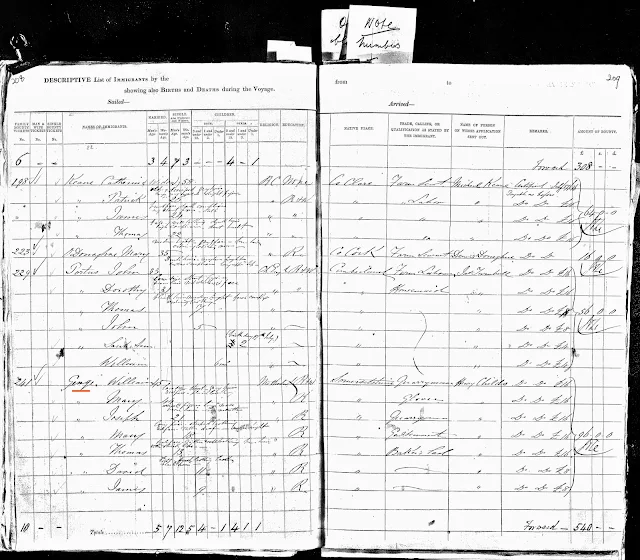
Source: Archives Office of Tasmania; Tasmania, Australia;
Descriptive List of Immigrants;
Film Number: SLTX/AO/MB/140;
Series Number: CB7/12/1/6-9
Source: https://stors.tas.gov.au/RGD35-1-67$init=RGD35-1-67P83
1881: DEATH of William GENGE
When William Genge died on 16 January 1881 at Melville St. Hobart, 78 years old, of apoplexy and paralysis, his close friend John Nevin snr wrote this lament:

"Lines written on the sudden and much lamented death of Mr William Genge who died at the Wesleyan Chapel, Melville-street, Hobart on the morning of 17th January 1881, in the 73rd year of his age" by John Nevin snr
Publication Information: Hobart : Pratt, printer, 1881.
Physical description: 1 sheet.
Record ID: SD_ILS:542990 State Library of Tasmania
Allport Library Pamphlets P 820.A NEV

Genge, William
Record Type: Deaths
Gender: Male
Age: 73
Date of death: 16 Jan 1881
Registered: Hobart. Registration year: 1881
Record ID: NAME_INDEXES:1228887
Resource: RGD35/1/9 no 2900
Archives Office of Tasmania
Link: https://stors.tas.gov.au/RGD35-1-9$init=RGD35-1-9P329
Addenda 2: Chandler family
1846: Arrival of William Chandler, Hobart, VDL
William Chandler, bootmaker from Dover, Kent, arrived at Hobart, Van Diemen's Land (Tasmania) on the Calcutta in October 1846 accompanied by his sister Mary Selina Chandler to join their brother, boat builder Jacob Bayley Chandler (Ref: Nicole Mays, For many years a boat builder : the life and life's work of Jacob Bayly Chandler 2011:65).

Arrival at Hobart, VDL, barque Calcutta, 486 tons, 24 October 1846
Wm Chandler and sister, steerage
Archives Office Tasmania
Link: https://stors.tas.gov.au/MB2-39-1-9P022

Photo of William Chandler (1825-1907)
Unattributed [?] possibly taken ca. 1875 at Thomas J. Nevin's studio which William Chandler leased from 1876 for his bootmaker's business.
Source: courtesy of Nicole Mays, email February 2023, recto only copied from microfilm at the Archives Office of Tasmania.
Link: https://stors.tas.gov.au/AI/NS434-1-93
Jacob Bayley Chandler married Martha Macbeth in 1861. She died aged 38, in 1867, daughter of Peter Macbeth.
DEATHS. CHANDLER.—On 7th April, at Battery Point, Martha, the beloved wife of Jacob Bailey Chandler, in the 38th year of her age.Death of Martha Chandler nee Macbeth
Source: Launceston Examiner (Tas. : 1842 - 1899), Tuesday 23 April 1867, page 4
1848: CENSUS (Tas)
William CHANDLER 17 Warwick St Hobart
2 persons male and female over 60 yrs old
MARRIAGES
1855: William Chandler , first marriage to Kezia Cox, 31 May 1855.
1868: William Chandler, second marriage to Mary Genge, 14 January 1868
1888: Ethel Mary Chandler (19) married William James Hooper (22), Clerk, on 18th November 1888 at the Hobart Congregational Church, witnesses were Mary Ann Hooper and William Chandler (No. 1287).
ALL CHANDLERS 1890-91
Chandler George, 70 Melville st. Hobart
Chandler George, Queen st. Sandy Bay
Chandler Henry B. McRobie's Gully, Cascades, Hobart
Chandler John, landholder, Snake Plains
Chandler John T. 4 Byron street, Hobart
Chandler John, Distillery Creek, Launcstn
Chandler John, Parliament st. Sandy Bay
Chandler John, produce dealer, Longford
Chandler John, corn dealer, Longford
Chandler John T. 8 Napoleon street, Battery Point, Hobart
Chandler Richard, 228 Brisbane st.Launcstn
Chandler Richard J. 84 Galvin st. Launcstn
Chandler Robert, general smith, 78 Wellington road, Launceston.
Chandler Robert H. musical instrument dealer 124 Liverpool street, Hobart
Chandler Robert H. Providence valley, Mt. Stuart
Chandler William, bootmaker, 39 Liverpool. st. Hobart
Chandler William, Woodbridge
Chandler William Park street, Newtown
Chandler William' craftsman, Kettering
Chandler Mrs. Wml. Bathurst st. Launceston
OTHER MEN NAMED WILLIAM CHANDLER in Tasmania
One was a mechanical engineer and inn keeper at Brisbane Hotel, Brisbane St. married to Annie Maria Taylor. Another was a farmer in Launceston. Another with his wife had a criminal record for manslaughter in 1903.
RESIDENCES and PROPERTIES
This is a selection only of some of the premises occupied by James Chandler and his father William Chandler snr in Hobart Tasmania between 1848 and 1946, together with a few listings of the Nevin and Genge families. Please note: this list is selective and incomplete of links to primary documents, most of which are available at the Archives Office of Tasmania (NAMES INDEX) and Familysearch.org.
1848: CENSUS VDL
William CHANDLER 17 Warwick St Hobart
2 persons male and female over 60 yrs old
1870: LAND & TITLES
Chandler, William bought over 2 acres for £380.
Record Type: Land
Date: 1870
Location: Glenorchy
Remarks: 2 acres, 1 rood, 11 perches
Record ID: NAME_INDEXES:1743112
https://stors.tas.gov.au/NI/1743112
1874: 18th November. LAND & TITLES
Chandler, William bought land along boundary of the Orphan School west from Main Road for £24.
Record Type: Land
Date: 1874
Location: New Town
Remarks: 21 1/10 perches
Record ID: NAME_INDEXES:1743115
https://stors.tas.gov.au/RD1-1-78$init=RD1-1-78P085JPG
1877: VALUATION ROLLS
Two allotments Main Road New Town W. Chandler occupier and owner W Chandler
House and shop, William Chandler 140 Elizabeth St. owner John Elliott, Brown St.
House and shop, 271 Eliz. St. (also called New Town Rd, Main Rd after Warwick St).
House shop land Thos Mullen and W. Genge owner Thos Mullen snr
1884: VALUATION ROLLS
House and shop, William Chandler 140 Elizabeth St. owner John Elliott, Brown St.
House, boat yard and workshops, Napoleon St. Jacob B. Chandler owner J. B. Chandler
New Wharf: house workshop dilapidated J. B. Chandler Alexander Mc Gregor
Ware St. John Chandler owner
Colville St. House John Chandler John Chandler
11 Goulburn St. Res John Chandler owner Mary A. Ray
Cottage and Garden Cascade-valley Chandler, Henry B. on property,owner
Schoolhouse and dwelling Kangaroo Valley Nevin John on property, Trustees Wesleyan Chapel New Town 1 acre
Garden ditto Nevin John, owner Mary Nairn New Town 1 acre
Dallas Arms, 269 Elizabeth St. Genge, Dallas Arms Anne Allen John Allen's estate
Land and House 271 Elizabeth St. William Genge Mrs Mullen 26
1885: VALUATION ROLLS
House, 76 Argyle St William Chandler, owner John T Smith Campbell St.
House and shop, 140 Eliz St William Chandler owner John Elliot
1886: VALUATION ROLLS
NB: by 1886 Elizabeth St numbers had changed.
Public House, 174 Eliz St. (formerly 142) occupier Frank Stewart, owner John Elliott, Brown St.
House and shop, 172 Eliz St. (formerly 140) William Chandler, owner John W Elliott ditto
1890: VALUATION ROLLS:
House, 132 Harrington St. Thomas Nevin jnr (Sonny Nevin) , owner Mrs Beedham
House and Shop 39 Liverpool St. William Chandler J P Rowe owner Victoria.
James Chandler was living here with his father Wm Chandler snr
1896-97: Tasmanian PO Directory Wises Directory 1896-97
https://stors.tas.gov.au/ILS/SD_ILS-203228
NEVIN, Thomas snr 82 Warwick St. between Elizabeth and Murray Sts
CHANDLER, William Bootmaker 39 Liverpool Street, 3 doors from Argyle St intersection
1906:
CHANDLER, James and father William Chandler, 241 Argyle St, on right side from Wharf.
Wm Chandler snr died in 1907
NEVIN, Thomas jnr - bootmaker 236 Eliz. St. aka Sonny - son of Thomas James Nevin snr
1916:
CHANDLER, Mrs Mary, 101 Warwick St. Hobart

The Tasmania post office directory.
Publication Information:
Hobart, Tas. : H. Wise & Co.. 1891-1937.
https://stors.tas.gov.au/ILS/SD_ILS-203228

Mrs Mary Chandler, mother of James Chandler, ca. 1915 (unidentified, but from the Chandler Collection)
Source: Archives Office Tasmania, https://stors.tas.gov.au/NS869-1-482
1938:
CHANDLER, James. Photographer 28 Liverpool St between Park St. and Campbell St.
1945-6:
CHANDLER, James, discrepancies in date of death, possibly because he died intestate. One source of death is 8th July 1945, another is date of will, 27 March 1946. James CHANDLER (1877-1946) late of McRobies Road, died at St Helens Hospital on 27 March 1946. Value of estate Pounds £332.2.
Source: https://stors.tas.gov.au/AD963-1-3-2867$init=AD963-1-3-2867_1

Visitors to the ruins of the Port Arthur Penitentiary 1930
Photographer: James Chandler
Source: https://stors.tas.gov.au/NS1231-1-88J2K$init=NS1231-1-88
RELATED POSTS main weblog
- John Nevin snr and the Genge family
- John Nevin's Wesleyan Lament
- John Nevin's marriages to Mary Ann Dickson and Martha Genge
- John Nevin senior's land grant 1859 at Port Cygnet
- Youngest daughter Minnie Nevin m. James Drew (1884-1974)
- Alfred Hope and his landau with Albert Nevin on horseback early 1900s
- NEVIN & SMITH, 1868: the client with white fingernails
- Captain Edward Goldsmith's "unwieldy steamer", the twin ferry "Kangaroo"


